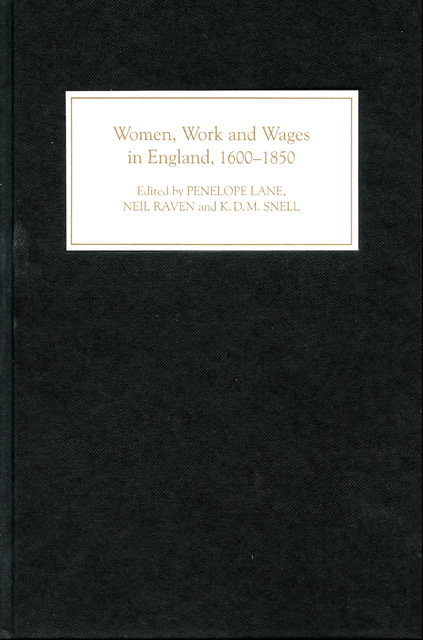Book contents
- Frontmatter
- Contents
- Illustrations
- Notes on Contributors
- Acknowledgements
- Introduction
- 1 ‘Waste’ Children? Pauper Apprenticeship Under the Elizabethan Poor Laws, c. 1598–1697
- 2 Gender at Sea: Women and the East India Company in Seventeenth-Century London
- 3 Sickles and Scythes Revisited: Harvest Work, Wages and Symbolic Meanings
- 4 A Customary or Market Wage? Women and Work in the East Midlands, c. 1700–1840
- 5 ‘Meer Pennies for My Baskitt Will be Enough’: Women, Work and Welfare, 1770–1830
- 6 Caring for the Sick Poor: Poor Law Nurses in Bedfordshire, c. 1770–1834
- 7 ‘A ‘Humbler, Industrious Class of Female’: Women’s Employment and Industry in the Small Towns of Southern England, c. 1790–1840
- 8 A Diminishing Force? Reassessing the Employment of Female Day Labourers in English Agriculture, c. 1790–1850
- Bibliography
- Index
5 - ‘Meer Pennies for My Baskitt Will be Enough’: Women, Work and Welfare, 1770–1830
Published online by Cambridge University Press: 21 March 2023
- Frontmatter
- Contents
- Illustrations
- Notes on Contributors
- Acknowledgements
- Introduction
- 1 ‘Waste’ Children? Pauper Apprenticeship Under the Elizabethan Poor Laws, c. 1598–1697
- 2 Gender at Sea: Women and the East India Company in Seventeenth-Century London
- 3 Sickles and Scythes Revisited: Harvest Work, Wages and Symbolic Meanings
- 4 A Customary or Market Wage? Women and Work in the East Midlands, c. 1700–1840
- 5 ‘Meer Pennies for My Baskitt Will be Enough’: Women, Work and Welfare, 1770–1830
- 6 Caring for the Sick Poor: Poor Law Nurses in Bedfordshire, c. 1770–1834
- 7 ‘A ‘Humbler, Industrious Class of Female’: Women’s Employment and Industry in the Small Towns of Southern England, c. 1790–1840
- 8 A Diminishing Force? Reassessing the Employment of Female Day Labourers in English Agriculture, c. 1790–1850
- Bibliography
- Index
Summary
Overview
The Introduction to this volume has shown that the issues of women’s labour force participation and remuneration are the subject of much debate. In terms of formal female labour force participation, some historians have suggested that opportunities for women workers were undermined by the revamping of the economic infrastructure taking place during the eighteenth and early nineteenth centuries. Even in proto-industrial areas, where it has long been accepted that there was a premium on the family labour force, technological redundancy hit women first and hardest. In agricultural regions of the Southeast and South midlands, Keith Snell argues persuasively that there was a marginalisation of women in the rural labour market occasioned by the decline of some rural industries, changing land use, harvest technology and farm reorganisation. In addition, feminist historians have traced in some detail attempts by employers and male workers to undermine the labour force participation of women in textile and other factories. Even in Lancashire, where it is conventional to see more in the way of economic opportunity for women of all ages compared to the rural south and east, there is considerable evidence – in settlement examinations and other documentation arising out of the poor law, for instance – that many women found it difficult to obtain long-term full-time employment. Other historians, however, have adopted a contrary view, arguing that the labour force role of women actually increased during the eighteenth and nineteenth centuries, as women carved out niche opportunities, reacted to opportunity in a rather faster and more flexible way than men, and colonised many of the newest trades that were to provide the growth areas of the nineteenth century. Indeed, the very presence of a pool of low paid female labour has been seen as a factor underpinning industrialisation processes in both England and Scotland. That we miss these developments, it is sometimes argued, reflects the fact that we misinterpret sources, look in the wrong places, or are beguiled by the invisibility of paid women’s work.
- Type
- Chapter
- Information
- Women, Work and Wages in England, 1600-1850 , pp. 119 - 140Publisher: Boydell & BrewerPrint publication year: 2004



